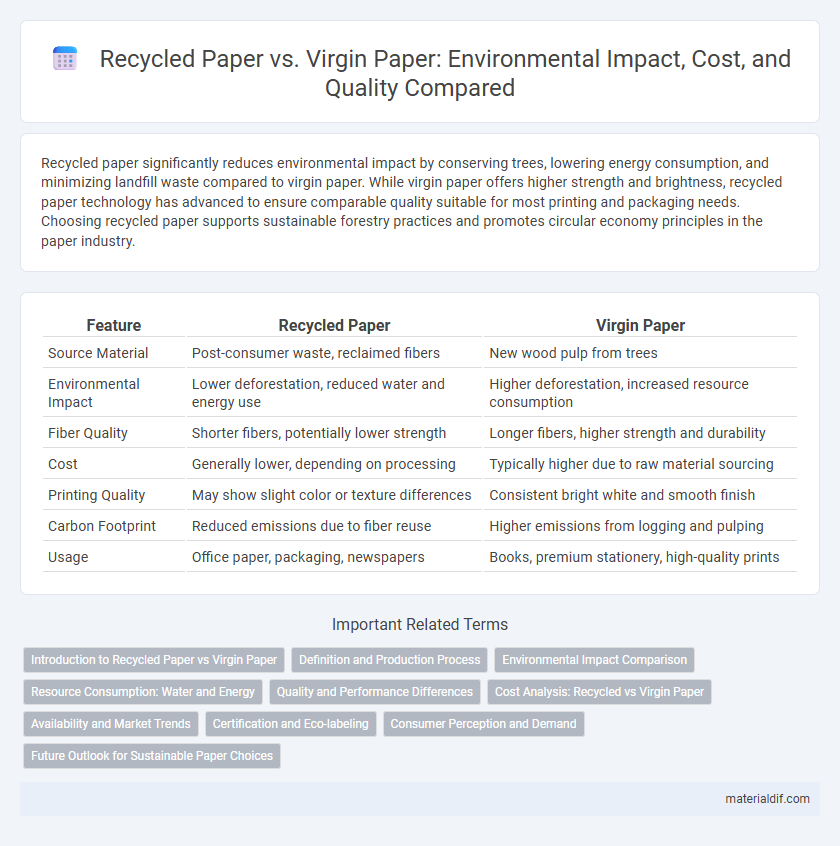Recycled paper significantly reduces environmental impact by conserving trees, lowering energy consumption, and minimizing landfill waste compared to virgin paper. While virgin paper offers higher strength and brightness, recycled paper technology has advanced to ensure comparable quality suitable for most printing and packaging needs. Choosing recycled paper supports sustainable forestry practices and promotes circular economy principles in the paper industry.
Table of Comparison
| Feature | Recycled Paper | Virgin Paper |
|---|---|---|
| Source Material | Post-consumer waste, reclaimed fibers | New wood pulp from trees |
| Environmental Impact | Lower deforestation, reduced water and energy use | Higher deforestation, increased resource consumption |
| Fiber Quality | Shorter fibers, potentially lower strength | Longer fibers, higher strength and durability |
| Cost | Generally lower, depending on processing | Typically higher due to raw material sourcing |
| Printing Quality | May show slight color or texture differences | Consistent bright white and smooth finish |
| Carbon Footprint | Reduced emissions due to fiber reuse | Higher emissions from logging and pulping |
| Usage | Office paper, packaging, newspapers | Books, premium stationery, high-quality prints |
Introduction to Recycled Paper vs Virgin Paper
Recycled paper is produced from recovered paper fibers, reducing the demand for fresh wood pulp and minimizing environmental impact compared to virgin paper, which is made from newly harvested trees. The manufacturing process of recycled paper consumes less energy and water, resulting in lower carbon emissions and less landfill waste. Virgin paper, while typically offering higher brightness and strength, contributes significantly to deforestation and resource depletion.
Definition and Production Process
Recycled paper is made from recovered fibers of used paper products, undergoing processes such as sorting, deinking, and re-pulping to produce new sheets, significantly reducing waste and conserving natural resources. Virgin paper is produced from freshly harvested wood pulp, involving mechanical or chemical pulping methods to extract fibers directly from timber, ensuring high strength and quality. The production of recycled paper emits fewer greenhouse gases and consumes less water and energy compared to virgin paper manufacturing.
Environmental Impact Comparison
Recycled paper significantly reduces deforestation by reusing fibers, lowering the demand for virgin wood pulp and preserving biodiversity. Production of recycled paper consumes 40-60% less energy and emits fewer greenhouse gases compared to virgin paper manufacturing, diminishing its carbon footprint. Wastewater from recycled paper processing contains fewer pollutants, contributing to less aquatic contamination than the chemical-intensive virgin paper production.
Resource Consumption: Water and Energy
Recycled paper production uses up to 50% less water compared to virgin paper manufacturing, significantly reducing freshwater consumption. Energy requirements for recycled paper are approximately 30-40% lower due to the absence of tree pulping and chemical processing stages. This reduction in water and energy consumption contributes to a smaller environmental footprint and supports sustainable resource management.
Quality and Performance Differences
Recycled paper often contains shorter fibers compared to virgin paper, which can result in a slightly lower strength and brightness, affecting print quality and durability. Virgin paper, made from fresh pulp, typically offers superior whiteness, smoothness, and consistency, making it ideal for high-quality printing and professional documents. Performance differences are also influenced by the recycling process, as contaminants and fiber degradation may impact the final paper's texture and opacity.
Cost Analysis: Recycled vs Virgin Paper
Recycled paper generally costs less to produce than virgin paper due to lower raw material expenses and reduced energy consumption, making it a cost-effective choice for businesses focused on sustainability. Virgin paper involves higher costs relating to fiber harvesting, chemical processing, and water usage, contributing to its overall premium price. Market fluctuations in supply chains and demand also influence the cost differential, with recycled paper prices often more stable due to reliance on recovered fiber sources.
Availability and Market Trends
Recycled paper availability has surged due to increased demand for sustainable products, with over 50% of paper mills incorporating recycled fibers to reduce environmental impact. The market trend shows a growing preference for recycled paper in packaging and printing industries, driven by consumer eco-consciousness and regulatory incentives. Meanwhile, virgin paper remains essential in specialized applications requiring high strength and quality, maintaining steady production levels despite sustainability pressures.
Certification and Eco-labeling
Recycled paper often carries certifications such as FSC Recycled or EU Ecolabel, indicating compliance with rigorous environmental standards and responsible sourcing practices. Virgin paper typically holds FSC or PEFC certifications, ensuring sustainable forest management and reduced environmental impact. Eco-labeling on both recycled and virgin paper provides consumers with transparent information about product sustainability, fostering informed purchasing decisions that support ecological preservation.
Consumer Perception and Demand
Consumers increasingly favor recycled paper due to its environmental benefits, perceiving it as a sustainable choice that reduces deforestation and waste. Market demand for recycled paper continues to rise, driven by growing awareness of ecological impact and corporate responsibility initiatives. Despite some concerns about quality, advancements in processing technology have improved recycled paper's durability and appearance, enhancing consumer acceptance.
Future Outlook for Sustainable Paper Choices
Recycled paper is projected to dominate the sustainable paper market due to increasing environmental regulations and consumer demand for eco-friendly products, reducing deforestation and lowering carbon footprints. Advances in recycling technology improve fiber quality and energy efficiency, making recycled paper more competitive with virgin paper in strength and appearance. Market trends indicate a growing preference for circular economy models, encouraging manufacturers to integrate recycled content and minimize waste in paper production.
Recycled Paper vs Virgin Paper Infographic

 materialdif.com
materialdif.com